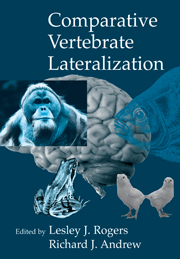Book contents
- Frontmatter
- Contents
- List of Contributors
- Preface
- Introduction
- Part one Evolution of lateralization
- 1 How ancient is brain lateralization?
- 2 The earliest origins and subsequent evolution of lateralization
- 3 The nature of lateralization in tetrapods
- 4 Advantages and disadvantages of lateralization
- Part two Development of lateralization
- Part three Cognition and lateralization
- Part four Lateralization and memory
- Epilogue
- Author Index
- Subject Index
- Richard Andrew
1 - How ancient is brain lateralization?
Published online by Cambridge University Press: 10 December 2009
- Frontmatter
- Contents
- List of Contributors
- Preface
- Introduction
- Part one Evolution of lateralization
- 1 How ancient is brain lateralization?
- 2 The earliest origins and subsequent evolution of lateralization
- 3 The nature of lateralization in tetrapods
- 4 Advantages and disadvantages of lateralization
- Part two Development of lateralization
- Part three Cognition and lateralization
- Part four Lateralization and memory
- Epilogue
- Author Index
- Subject Index
- Richard Andrew
Summary
Introduction
This chapter is devoted to discussion of the evolution of lateralization. We have limited ourselves to vertebrates, and concentrated in particular on the so-called lower vertebrates (i.e. fishes, amphibians and reptiles). We think that we should declare our position from the start: we believe that, in its basic and fundamental form, lateralization among higher vertebrates (i.e. birds and mammals) is a phenomenon of homology (i.e. that it has been inherited from a common ancestor). We also believe that important clues to the evolution of lateralization can be obtained by investigation of extant vertebrate forms, particularly fish, which are likely to come closest to retaining the original conditions under which lateralization probably first appeared in early chordates.
A Brief History of the Comparative Study of Lateralization
The discovery of functional brain lateralization in the human being is associated with the classical observations by Broca in 1861 and, more recently, its study received renewed impetus from the work carried out on split brain patients by Sperry and his associates in the 1960s.
Interestingly, for a very long time it was maintained that there were no anatomical data that could be associated with functional asymmetries in humans (von Bonin, 1962). The first contrary evidence came in 1968, when Geschwind and Levitsky reported that the planum temporale, which is part of Wernicke's area, is larger in the left than in the right hemisphere. Thus, in humans, observations on functional asymmetries preceded evidence of structural asymmetries.
- Type
- Chapter
- Information
- Comparative Vertebrate Lateralization , pp. 9 - 69Publisher: Cambridge University PressPrint publication year: 2002
- 69
- Cited by



